Jefferson Barracks Military Post
| Jefferson Barracks Military Post | |
|---|---|
| Lemay, Missouri | |
|
Jefferson Barracks Red Brick Barrack Buildings. | |
| Type | U.S. Military Post |
| Site information | |
| Controlled by | Army National Guard, Air National Guard |
| Site history | |
| Built | 1826 |
| In use | 1826-1946 |
| Garrison information | |
| Garrison |
Army National Guard, Air National Guard, Veterans Administration |
|
Jefferson Barracks Historic District | |
 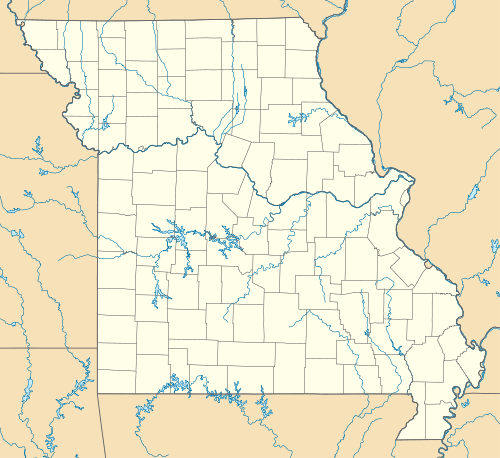  | |
| Nearest city | St. Louis County, Missouri |
| Area | 337.8 acres (136.7 ha) |
| Built | 1826 |
| Architectural style | Other, Military vernacular |
| NRHP Reference # | 72001492[1] |
| Added to NRHP | February 1, 1972 |
The Jefferson Barracks Military Post is located on the Mississippi River at Lemay, Missouri, south of St. Louis. It was an important and highly active U.S. Army installation from 1826 through 1946. It is the oldest operating U.S. military installation west of the Mississippi River, and it is now used as a base for the Army and Air National Guard.
History
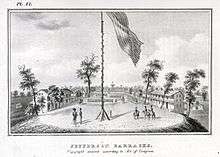
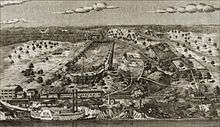


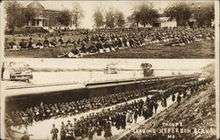
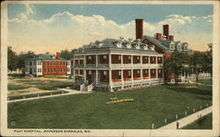
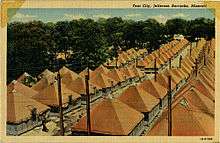
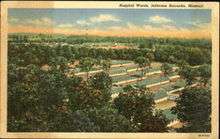

In 1826 General Edmund P. Gaines (Commander of the Western Department of the Army), Brig. General Henry Atkinson (commanding officer of the sixth infantry regiment), explorer William Clark, and Missouri Governor John Miller spent several days searching the banks of the Mississippi River for the perfect location for a new post to replace Fort Bellefontaine. A site near the city of "Vide Poche" or Carondelet, ten miles (16 km) south of St. Louis, was recommended and then approved by Major General Jacob J. Brown, Commanding General of the Army.
On July 10, 1826, two days after the deed to the land was signed, the first military troops—six officers and 245 enlisted men of Companies A, B, H and I, commanded by Brevet Major Stephen Watts Kearny—arrived at the new post and started building temporary quarters that they named Cantonment Miller in honor of Governor Miller. In 1827 the military post was formally named Jefferson Barracks in honor of Thomas Jefferson who had died the year before. Even William Clark's son, Meriwether Lewis Clark, Sr., would join the ranks of Jefferson Barracks. It was also designated the first "Infantry School of Practice."[2]
The first conflict that the men of Jefferson Barracks were involved with was the Black Hawk War in 1832. Troops were deployed from Jefferson Barracks to push "hostile Indians" back into their village in present-day Iowa. Chief Black Hawk was captured and brought back to Jefferson Barracks.
In 1832, the United States Regiment of Dragoons were formed and stationed at Jefferson Baracks. The dragoons, trained to fight mounted or dismounted, were the first unit of permanent cavalry in the United States Army and were later called the 1st U.S. Dragoons.
Mexican–American War
Jefferson Barracks became a major military post during the Mexican–American War (1846–1848) when it served as a rest and supply station for most U.S. troops deploying to Mexico. Jefferson Barracks was the recruiting center for outfitting and training most of the regiments organized for the Mexican War in 1846, and upon the return of the triumphant U.S. forces in 1848, many were deployed to Jefferson Barracks due to its strategic location and healthful situation.[3]
In 1853, newly elected President Franklin Pierce,who had served as a brigadier general during the Mexican War, appointed Jefferson Davis as his Secretary of War.
At Jefferson Barracks, Davis soon organized the 2nd U.S. Dragoons, known derisively as "Jeff Davis's Pets," because the commissioned personnel assigned to them were the best in the Army. Albert Sidney Johnston served as colonel and Robert E. Lee as lieutenant colonel. A list of the officers of the 2nd U.S. Dragoons includes some of the ablest commanders of the U.S. Civil War.[3]
Civil War
During the American Civil War (1861–1865), Jefferson Barracks served as a military hospital for both sides and a recruitment depot for the North. In 1862 construction of the Western Sanitary Commission's hospital facilities began at Jefferson Barracks. By the time that the hospital complex was complete, it could hold 3,000 patients. By the end of the first year of the war, over 5,000 sick and wounded had been admitted and, by the end of the war, well over 18,000 soldiers had been treated at Jefferson Barracks Hospital. In 2002, The Missouri Civil War Museum was founded, which is still being restored today. The MCWM is being brought to life in the old 1905 Post Exchange Building.
Spanish–American War
With the declaration of the Spanish–American War in 1898, many regular army and volunteer regiments were, once again, formed and outfitted at Jefferson Barracks. Jefferson Barracks was permanently designated as a recruiting depot in 1906, despite the fact that it had been used as such intermittently throughout its use through generations.
World War I
On March 1, 1912 Jefferson Barracks involves its place in the world as the main base for the first aviation parachuting. Albert Berry became the first person to ever successfully parachute from an airplane, which was being flown by Anthony Jannus over the field.
During World War I, Jefferson Barracks served as a training and recruitment station for soldiers heading to Europe.
During the 1930s, the Citizens Military Training Camp or CMTC was held at Jefferson Barracks. Young men could spend one month a year at the post being trained as a soldier, and after three years they could enter the military. Also during that time the Works Progress Administration (WPA) had camps at Jefferson Barracks.
World War II
During World War II, Jefferson Barracks was a major reception center for U.S. troops being drafted into the military. It also served as an important basic training site for the Army, then later was the first Army Air Corps Training Site. Elements of the Central (later Eastern) Technical Training Command were stationed at the barracks.
During World War II, Jefferson Barracks had a peak area of 1,518 acres (6.14 km²), and had billeting space for 16 officers and 1,500 enlisted persons.
Jefferson Barracks was decommissioned as a military post in 1946 with the end of World War II.
Post-World War II
After Jefferson Barracks was decommissioned, portions of the grounds were sold off for construction of houses. Some of the barracks were acquired by the St. Louis County Housing Authority as temporary low-cost housing. Those were demolished in the 1960s and replaced by the current Jefferson Townhomes development. Bishop DuBourg High School was located on the Jefferson Barracks property for several years in the early 1950s. The former Jefferson Barracks School is now used for storage and maintenance; and the former theater is St. Bernadette Catholic Church.
It is now the site of two St. Louis County Parks (Jefferson Barracks County Park and Sylvan Springs County Park), a National Guard Base (Army and Air), the Jefferson Barracks National Cemetery and a Veterans Administration hospital. Part of the hospital grounds were donated to the Mehlville School District in the 1960s to build Charles S. Beasley Elementary School.
Today, the 135-acre National Guard post at Jefferson Barracks is home to the 70th Troop Command, the Missouri Army National Guard's largest brigade. The post is also headquarters for the Region 7 Homeland Response Force; the Missouri Air National Guard's 157th Air Operations Group and the 10th Psychological Operations Battalion of the U.S. Army Reserve. Beginning in late 2012, military intelligence operations will begin in building 27; these operations will be similar to those occurring at existing locations on both coasts.[4]
During the 1960s and 1970s, portions of Jefferson Barracks County Park were used as a landfill. During the 1980s, an annual balloon race was held in the park. Today, because of its large size, high school cross country races are often held in the park in the fall months, most notably the Hancock Invitational.
Museums
Jefferson Barracks Museums
Jefferson Barracks County Park includes the Jefferson Barracks Museums, two museums that house artifacts and history of Jefferson Barracks while it was an active United States Military Post.[5] The Powder Magazine Museum focuses on the history of Jefferson Barracks from its inception in 1826 until its closure in 1946. The Old Ordnance Stable features temporary exhibits with military themes.[6]
Missouri Civil War Museum
The Missouri Civil War Museum opened in the park in 2013.[7] Displays focus on the state's role during the American Civil War and include weapons, equipment, medical equipment, photographs and uniforms.[8]
Jefferson Barracks Telephone Museum
Besides its extensive collection of telephones manufactured from the 1900s through the 2000s, the Jefferson Barracks Telephone Museum also contains a working Central Office Step Switch, military telephones from World War II through the Vietnam War, hundreds of pieces of telephone-related equipment and tools, a telephone pole complete with climbing equipment, hundreds of pieces of telephone-related memorabilia from the 1880s through the 2000s, a large variety of novelty telephones, a special portable switchboard set up when U.S. Presidents Carter, Ford, Nixon and Johnson were visiting St. Louis and a sculpture of Alexander Graham Bell and history of the invention of the telephone.[9]
The self-guided, accessible museum has many hands-on, how-things-work displays.[10]
Army Units Organized at Jefferson Barracks
- U.S. 1st Cavalry Regiment – March 4, 1833 (Originally United States Regiment of Dragoons).
- 2d Armored Cavalry Regiment – May 23, 1836 (Originally 2nd Regiment of Dragoons)
- 3d Armored Cavalry Regiment – October 12, 1846 (Originally Regiment of Mounted Riflemen)
- U.S. 4th Cavalry Regiment – March 26, 1855 (Originally 1st Cavalry Regiment)
- U.S. 22d Infantry Regiment – December, 1865 (Originally 3rd Battalion, 13th Infantry Regiment)
Air Force Units Organized at Jefferson Barracks
- 157th Air Operations Group
- 131st Tactical Fighter Group, later 131st Fighter Wing, now 131st Bomb Wing
- 239th Combat Communication (CBCS) Squadron
- 266 Ground Electronics Engineering Installation Agency (GEEIA) Squadron.
- 218th Engineering Installation Squadron
See also
 Members of 157th Air Operations Group prepare to eat at the Mess Hall of Jefferson Barracks.
Members of 157th Air Operations Group prepare to eat at the Mess Hall of Jefferson Barracks.
References
- ↑ National Park Service (2010-07-09). "National Register Information System". National Register of Historic Places. National Park Service.
- ↑ U.S. Army Infantry Homepage
- 1 2 "Jefferson Barracks". Retrieved 25 June 2011.
- ↑ "New role for historic Jefferson Barracks". ArmyTimes. Associated Press. 28 December 2012. Retrieved 29 December 2012.
- ↑ "Jefferson Barracks Museums". St. Louis County, Missouri Parks and Recreation. Retrieved 16 November 2015.
- ↑ "Museums". Friends of Jefferson Barracks. Retrieved 16 November 2015.
- ↑ "Civil War museum opens at Jefferson Barracks". St. Louis Post-Dispatch. June 14, 2013. Retrieved 16 November 2015.
- ↑ "Official site". Missouri Civil War Museum. Retrieved 16 November 2015.
- ↑ Russell, Stefene (September 2016). "Call Me Maybe: Exploring Jefferson Barrack's New Telephone Museum". St. Louis Magazine.
- ↑ "Phones of All Shapes, Sizes and Colors". Webster-Kirkwood Times. St. Louis. June 3, 2016.
External links
Coordinates: 38°29′41″N 90°16′55″W / 38.49465°N 90.28187°W


